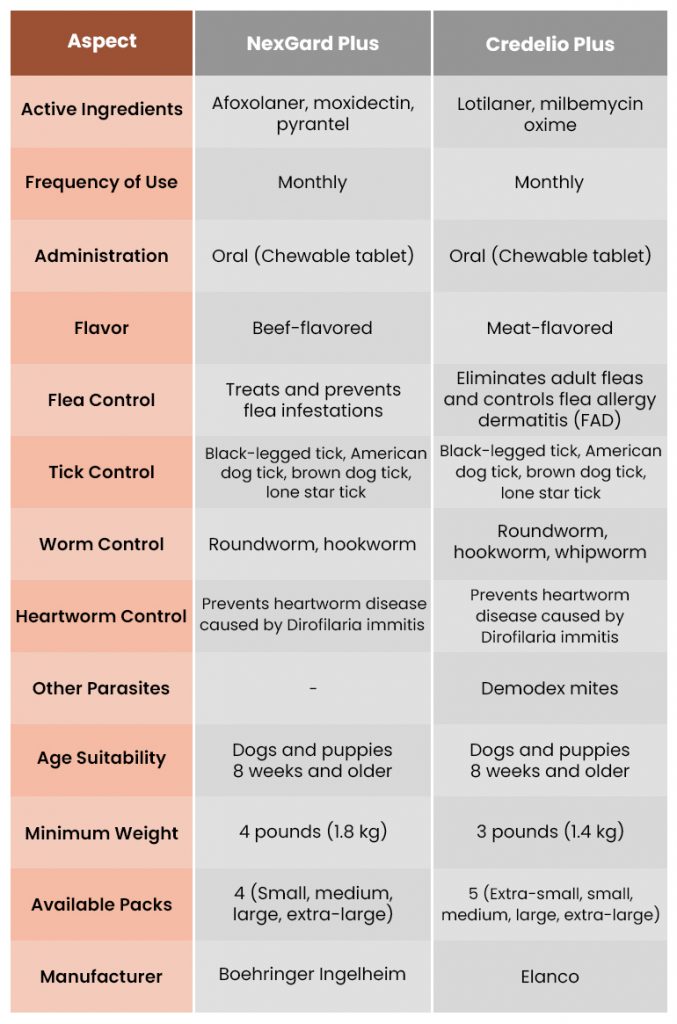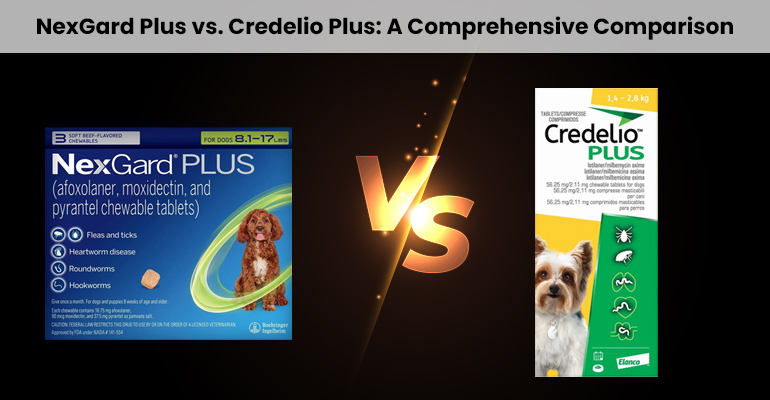NexGard Plus vs. Credelio Plus: A Comprehensive Comparison
As pet parents, ensuring the health and well-being of our furry companions is a top priority. One of the most significant threats to our pets’ health is the presence of parasites (fleas, ticks, intestinal worms and heartworm) which can lead to discomfort, disease, and even more severe health issues. In the market for flea, tick, worm and heartworm treatments, two prominent contenders are NexGard Plus and Credelio Plus.
In this comprehensive blog, we will delve into the product information, key similarities, differences, and provide a detailed comparison chart to help you make an informed decision when it comes to safeguarding your pet’s health.
NexGard Plus –One-And-Done Monthly Parasite Protection
NexGard Plus is a monthly chewable tablet designed to provide comprehensive protection against fleas, ticks, and various types of worms, including, adult hookworms, and roundworms, while also preventing heartworm disease in dogs. The active ingredients in NexGard Plus, afoxolaner, moxidectin and pyrantel, work together to effectively kill parasites and disrupt their life cycle, ensuring the well-being of your canine companion. NexGard Plus is a monthly beef-flavored chewable tablet suitable for dogs of 8 weeks of age and older, weighing at least four pounds
Know More About : NexGard PLUS: One-And-Done Monthly Protection for Dogs
Credelio Plus – 4 in 1 Protection in the Smallest Chew
Credelio Plus is a monthly chewable tablet that offers broad-spectrum protection against fleas, ticks, heartworm, and intestinal worms, such as roundworms, hookworms, and whipworms. It is also effective against demodex mite infestation. Its active ingredients, lotilaner and milbemycin oxime, target parasites with a focus on fast-acting and long-lasting efficacy, providing comprehensive care for your dog’s well-being. Credelio Plus is a monthly chewable tablet suitable for dogs of 8 weeks of age and older, weighing at least three pounds.
Key Similarities – Revealing the Common Ground
1. Both NexGard Plus and Credelio Plus are oral chewable tablets designed to protect dogs against fleas, ticks, worms and heartworm.
2. They are both monthly treatments, providing continuous protection for your pet.
3. Both products are suitable for dogs of 8 weeks of age and older
4. They are both effective against various species of ticks, including the American dog tick, black-legged tick, lone star tick and brown dog tick.
Key Differences – Spotting the Contrasts
1. NexGard Plus contains afoxolaner, moxidectin and pyrantel, while Credelio Plus contains lotilaner and milbemycin oxime. The difference in active ingredients may influence the spectrum of protection and potential side effects.
2. While both products effectively control fleas, the specific mechanism and duration of flea protection may vary.
3. The speed of kill and duration of tick protection may differ between the two products.
4. NexGard Plus is a beef-flavored chewable tablet, while Credelio Plus comes in a meat flavour chewable form. The ease of administration may vary depending on your pet’s preferences.
5. Credelio Plus also provides protection against demodex mites while NexGard Plus is not recommended for mite control.
Comparison Chart – A Detailed Comparison
Below is a comparison chart highlighting the key features of NexGard Plus and Credelio Plus, two popular options for protecting dogs against fleas, ticks, worms, and heartworm. This side-by-side comparison will help you make an informed decision based on factors such as age suitability, action time, and overall efficacy, ensuring the best care for your canine companion.

NexGard Plus or Credelio Plus -Choose Wisely for Your Furry Friend
Both NexGard Plus and Credelio Plus are effective options for protecting your dog against harmful parasites. When considering these two options, it’s essential to consult with your veterinarian to determine the specific needs of your dog. Factors such as your dog’s health, age, weight, and any existing medical conditions should be taken into account when choosing the most suitable treatment. Additionally, your veterinarian can provide valuable insights into the efficacy and safety of each product based on your dog’s individual requirements.
Ultimately, the decision between NexGard Plus and Credelio Plus should be based on a thorough understanding of your dog’s health needs, as well as the advice of a qualified veterinary professional. By prioritizing your dog’s well-being and seeking expert guidance, you can make an informed choice that ensures optimal protection against fleas, ticks, worms, and heartworm for your beloved pet.
NexGard Plus and Credelio Plus – FAQs
Q: Are NexGard Plus and Credelio Plus safe for all dog breeds?
A: Both products are generally safe for use in most dog breeds, but it’s essential to consult with a veterinarian to determine the best option for your pet’s specific needs.
Q: Can NexGard Plus and Credelio Plus be used in puppies?
A: NexGard Plus is approved for puppies as young as 8 weeks old and weighing at least 4 pounds, while Credelio Plus is approved for puppies at least 8 weeks of age and weighing at least 3 pounds.
Q: Are there any known drug interactions with NexGard Plus or Credelio Plus?
A: It’s important to inform your veterinarian about any other medications or supplements your dog is taking to avoid potential interactions.
Q. Are there any breed restrictions for using NexGard Plus or Credelio Plus?
A: There are no specific breed restrictions for using NexGard Plus or Credelio Plus.
Q. Can NexGard Plus and Credelio Plus be used in pregnant or lactating dogs?
A: It is recommended to consult with a veterinarian before using NexGard Plus or Credelio Plus in pregnant or lactating dogs.
Q. How often should NexGard Plus and Credelio Plus be administered to my dog?
A: Both NexGard Plus and Credelio Plus are administered as monthly chewable tablets.
Q. What should I do if my dog accidentally ingests NexGard Plus or Credelio Plus?
A. If your dog accidentally ingests NexGard Plus or Credelio Plus, contact your veterinarian or a poison control center immediately for guidance.




